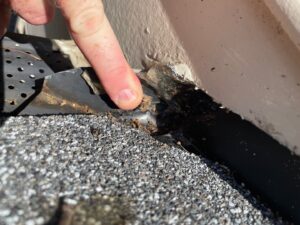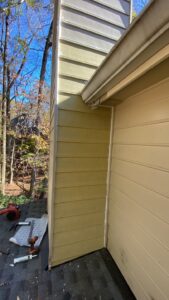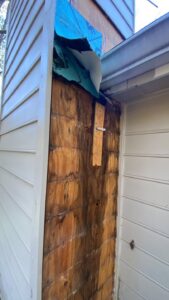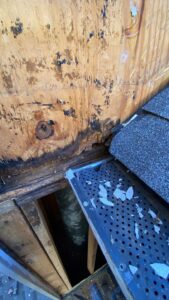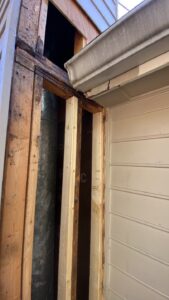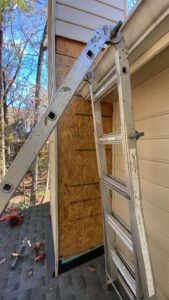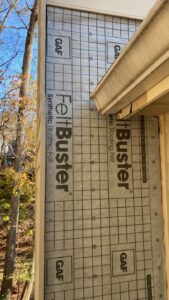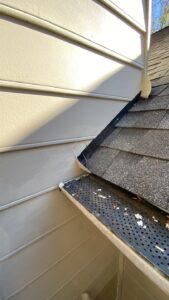Beyond the Roof:
Addressing Hidden Leaks Around Your Chimney
Chimney leaks can be deceptive. They often masquerade as roof leaks, and pinpointing their source requires a keen eye and extensive expertise. Leaks can occur for various reasons, such as a cracked chimney cap, a faulty chimney design, missing kick-out flashing, or improperly installed flashing.
Common chimney repairs address problems such as roof leaks, chimney cracks, leaning chimneys, and damaged chimney siding.
Key Takeaways
- Chimney leaks can be challenging to diagnose and are often mistaken for roof leaks. They require professional expertise to identify and fix issues like cracked chimney crowns or damaged liners.
- Regular chimney inspections and siding repairs are crucial to prevent leaks and maintain the structure’s integrity while ignoring issues that can lead to significant damage and higher repair costs.
- Professional chimney repair includes a thorough inspection process and may involve correcting hidden problems such as missing flashing, rot behind siding, and damaged decking to prevent future leaks and structural issues.
A Client’s Challenge: A Persistent Roof Leak
Recently, we faced a challenging situation. A client in Alpharetta approached us, puzzled and frustrated by a persistent roof leak. Water leaks can be elusive, often leading homeowners on a wild goose chase. Understanding their predicament, we scheduled an appointment to inspect the home and find the root cause.
Armed with our tools and experience, we approached the task like detectives on a mission, leaving no stone unturned. Our target was to stop the leak and ensure it didn’t return, a task easier said than done. But we were determined to provide our client with a comprehensive solution, not just a temporary fix.
Our Inspection Process: Tracing the Leak to the Chimney
As part of our detailed inspection process, we started with:
- A thorough examination of the roof: We look for signs of wear and tear, such as missing or damaged shingles, loose flashing, and clogged gutters. We also check for signs of deterioration around the chimney.
- A close inspection of the chimney: We look for cracks in the chimney cap, wall damage, and missing flashing. We also check for cricket to deter water from the base of the chimney.
- An inspection of the siding around the chimney: We look for signs of water damage, such as rot, mold, and mildew. We also check for any gaps or cracks in the siding that could allow water to enter.
Finally, our search led us to the chimney. And there it was, the hidden culprit. The chimney, or more precisely, a missing component of the chimney, was causing the persistent leak.
The Hidden Culprit: Missing Flashing
Flashing is one of the unsung heroes of a home’s architectural design. It’s a specialized component that diverts water from the chimney and roof into the gutter, preventing it from seeping under the roof or siding. When missing or damaged, water tends to find its way into the smallest of cracks, leading to leaks and, ultimately, water damage.
In our case, the missing kick-out flashing was the primary cause of the roof leak.
An Unsettling Discovery: Rot Behind the Chimney Siding
As we suspected, we uncovered another more concerning issue—rot behind the chimney’s siding. Rot is one of those silent enemies that can cause significant damage before it’s even detected. It’s like a termite that slowly but surely eats into a building’s structural integrity.
In this case, the rot was hidden behind the siding, out of sight and, therefore, out of mind. But it was there, silently causing damage that, if left unchecked, could lead to grave structural issues.
Our goal was not just to fix the leak but to ensure the overall health of the chimney and, by extension, the entire home.
Repairing the Chimney Leak
Damaged Decking
With the rot discovered and the cause of the leak identified, the homeowner gave us the green light to proceed with the necessary repairs. So, we rolled up our sleeves and got down to business. Our first task was to address the damaged decking.
The process involved removing and replacing the damaged sections with new, sturdy materials. Damaged decking, if not addressed, can lead to structural instability over time, so it was crucial to replace the damaged parts to ensure the longevity and safety of the structure.
Installing New Flashing: Preventing Future Leaks
We installed new flashing, ensuring it was correctly positioned to divert water from the chimney and prevent future leaks. The new flashing was designed to withstand the rigors of weather and time and provide a durable solution to the leak problem.
Replacing The Siding: Fortifying the First Line of Defense
Next, we turned our attention to the siding. This element is the first line of defense against water intrusion, and any damage can lead to leaks and further deterioration. The damaged siding had to go. We installed the underlayment and then the siding. We then painted the siding to match the existing color and cleaned it up, finishing the chimney repair.
Precision, Care, and Comprehensive Solutions
By the time we finished, we had addressed the existing chimney leak and fortified the home against future issues. We believe in going above and beyond to safeguard our clients’ homes. We don’t just fix problems; we provide comprehensive solutions that offer peace of mind.
Whether you’re dealing with a persistent roof or chimney leak, don’t hesitate to seek professional help. Our team at Fowler Exteriors is always ready to provide professional service and give you the peace of mind you deserve.
